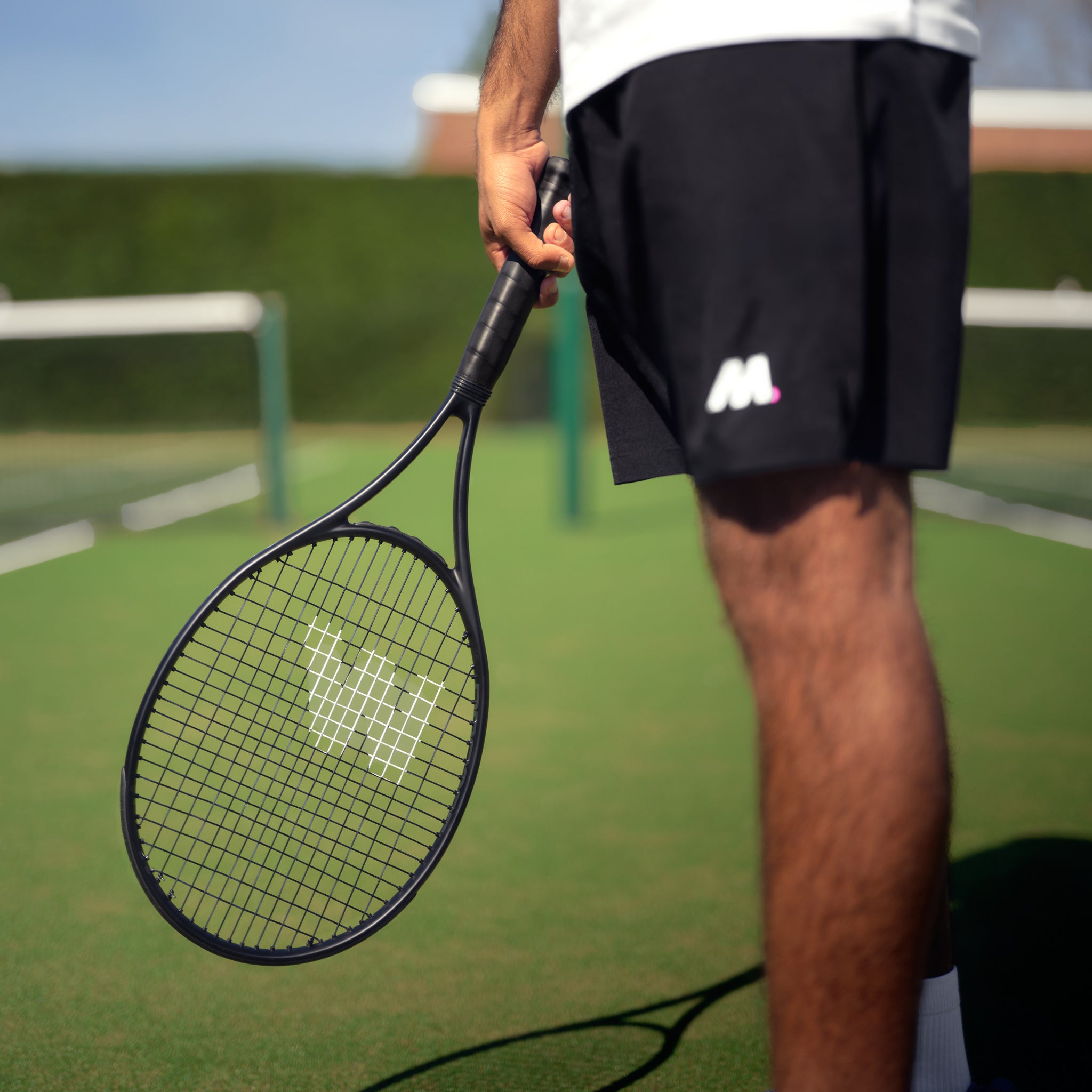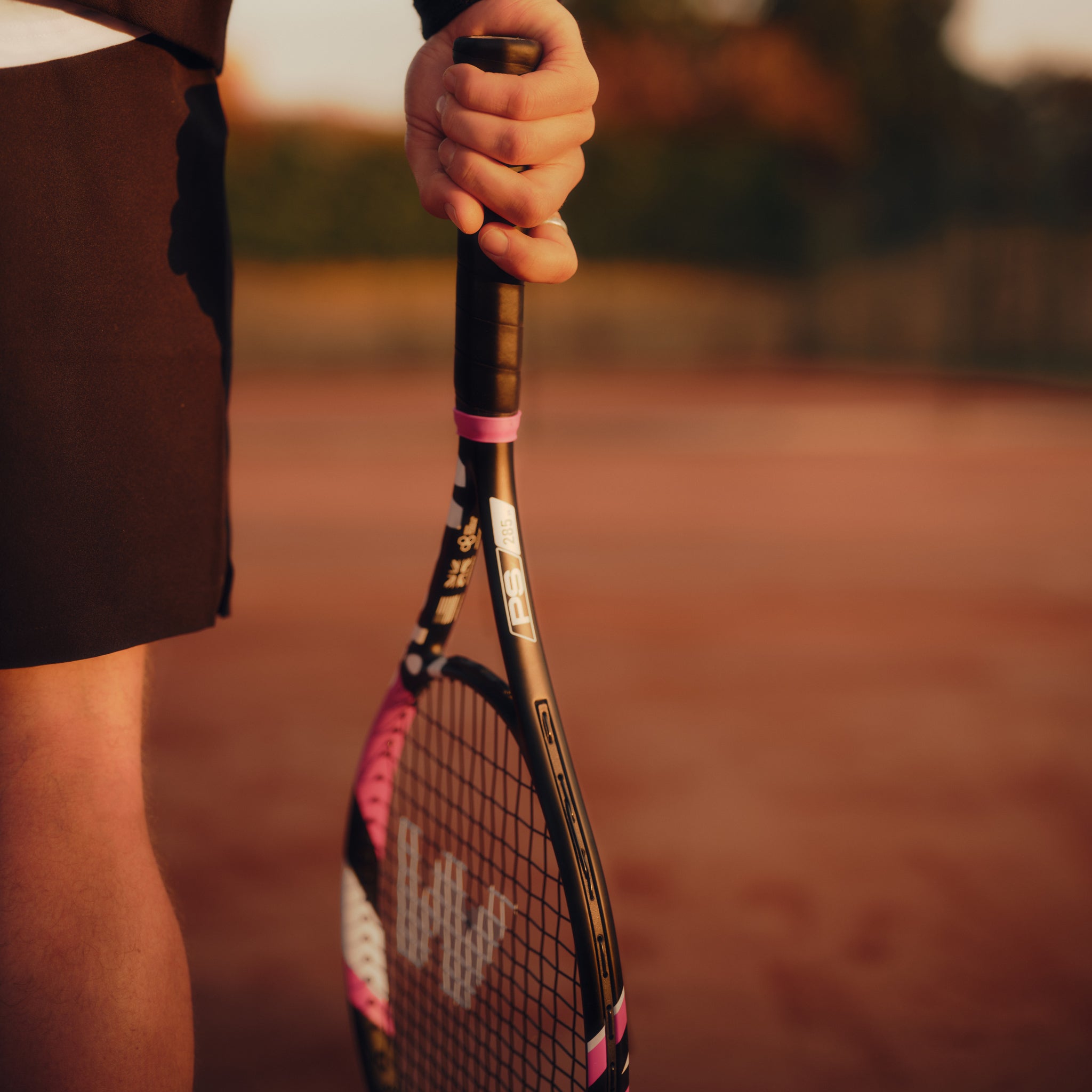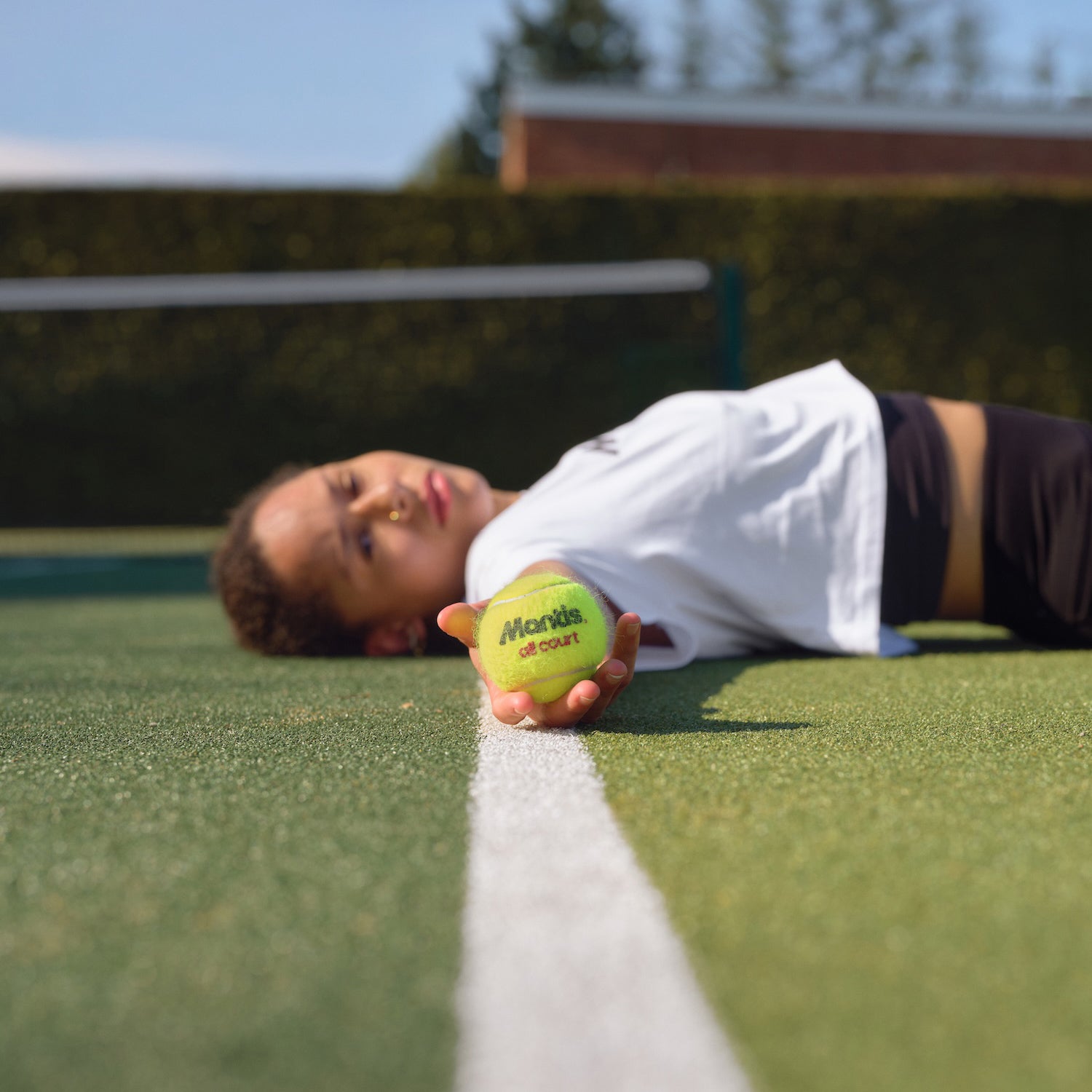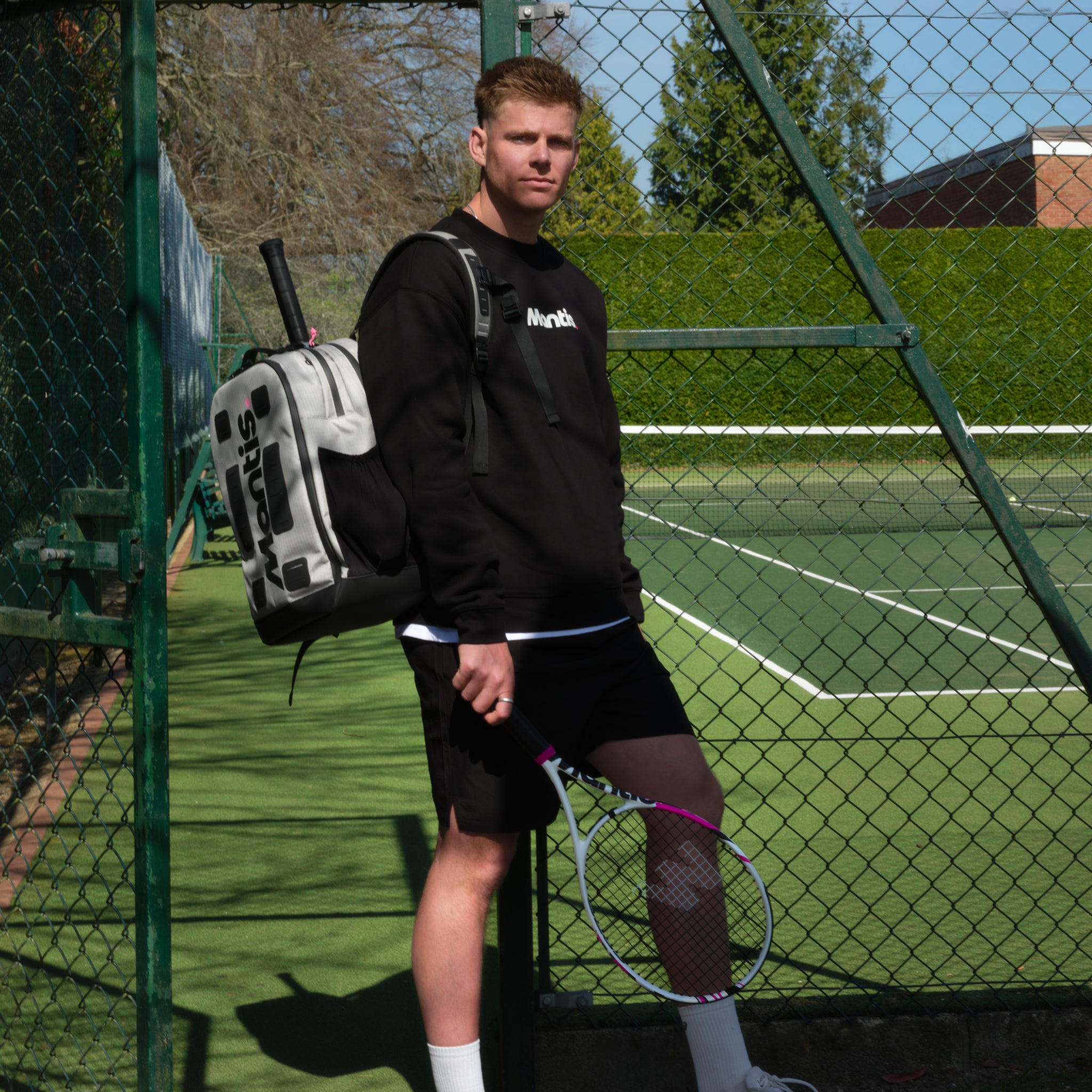
Picking the right racket is fundamental to enjoying your game and, more importantly, improving it. But let's be honest, the process of buying a tennis racket can feel like you need a degree in physics. For a complete breakdown, our guide on how to choose a tennis racket is a great place to start.
At Mantis, we believe the most critical first step has nothing to do with a specific frame. It starts with you. Understanding your own game is the only way to find a racket that truly works for you, not against you.
How to Choose Your Perfect Racket
Starting the hunt for a new racket is an exciting time for any player. It’s easy to get sidetracked by technical jargon and a wall of specs, but the best place to begin is with a simple, honest look in the mirror—metaphorically, of course. This self-assessment grounds every decision you make in what you actually need on the court. For a complete breakdown, our guide on how to choose a tennis racket is a great place to start.
The aim isn't to find the racket a pro uses on TV. It's to find one that complements your game. This self-discovery process saves you from buying a frame that's too advanced or totally unsuited to your natural style, which can slow your progress and even lead to injury.
Honestly Assess Your Skill Level
First things first: you need to define where you are on your tennis journey right now. Are you just starting out and learning the basic strokes? Are you an intermediate player who can hold a rally and is looking to add more shots? Or are you a seasoned competitor playing regular matches?
-
Beginner Player: You're new to the game or play infrequently. Your main goal is getting the ball over the net consistently. Your strokes are still developing, so you need a forgiving racket that helps generate power without you having to swing out of your shoes.
-
Intermediate Player: You play regularly, can direct your shots, and are starting to use spin. You've got the fundamentals down but are working on consistency and building a more versatile game.
-
Advanced Player: You have well-developed strokes, create your own power, and probably play in leagues or tournaments. You need a racket that offers pinpoint control, feel, and precision to execute your game plan.
Being truthful here is key. Picking up a racket built for an advanced player when you're still developing your strokes can be incredibly frustrating. Those frames are often heavier, less powerful, and far less forgiving on off-centre hits.
A racket should feel like a natural extension of your arm, not a foreign object you have to fight. The right frame enhances your strengths and helps mitigate your weaknesses, giving you the confidence to play your best tennis.
To help you connect player level with the right gear, this quick reference table breaks down the key specifications to look for.
Quick Racket Spec Guide by Player Level
| Player Level | Head Size (sq. in.) | Weight (Unstrung) | Balance | Key Benefit |
|---|---|---|---|---|
| Beginner | 102+ | 255-280g | Head-Heavy | Forgiveness & Easy Power |
| Intermediate | 98-102 | 285-305g | Even to Head-Light | All-Round Performance |
| Advanced | 95-98 | 310g+ | Head-Light | Control & Precision |
This table is a great starting point, but remember that personal preference and playing style will always play a huge role in the final decision. And feel free to consult with a tennis expert if you still have questions
Evaluate Your Playing Style
Next, think about how you approach a point. Your game style dictates the performance you'll need from your racket. While most of us are a blend of styles, we usually lean towards one primary philosophy.
What are your natural tendencies on the court? Do you love grinding it out from the baseline, or do you look for any excuse to rush the net? Do you hit flat, powerful drives, or do you use heavy topspin to push your opponent back?
-
Baseline Grinder: If you thrive on long, gruelling rallies from the back of the court, you’ll want a racket that provides stability and a solid mix of power and control.
-
Aggressive All-Courter: For players who mix up powerful groundstrokes with net attacks, a racket that is both manoeuvrable and stable is the sweet spot. It needs to feel good everywhere.
-
Serve-and-Volleyer: This classic style demands a racket with exceptional feel and quick responsiveness at the net. A lighter, more head-light frame is often preferred for lightning-fast reactions.
This initial self-assessment is the foundation for making a smart purchase. It’s also interesting to see how the wider fitness boom in the UK is bringing more people to sports like tennis. With UK fitness memberships hitting 11.5 million and industry income up 8.8% to £5.7 billion, there’s a growing demand for quality equipment that can help new and returning players get the most out of their time on court.
Decoding Racket Specifications for Your Game
Once you’ve got a handle on your playing style, it's time to get into the nitty-gritty. The numbers and terms you see on a racket frame aren't just marketing fluff; they're the DNA of its performance. This is where you translate that self-awareness into the hardware in your hand. For an even deeper dive into the numbers, Mantis has a great guide on understanding tennis racket specifications that’s well worth a read.
Demystifying these specs is the most important part of buying a racket that actually works for you, not against you.
Head Size: The Sweet Spot and Forgiveness
This is one of the most straightforward specs, but it has a massive impact on feel. Measured in square inches, the head size is all about the string bed's surface area, which determines the size of the "sweet spot"—that perfect area for making clean contact.
- Larger Heads (105 sq. in. and up): Often called "oversize" frames, these offer a huge sweet spot. That makes them incredibly forgiving on off-centre hits, which is a massive confidence booster for beginners. The larger string bed also creates a trampoline effect, generating easy power.
- Mid-Plus Heads (98-104 sq. in.): This is the sweet spot for a huge range of players. It’s the most popular size for a reason, providing a fantastic blend of power and control that’s perfect for intermediates who have their strokes dialled in but still appreciate a bit of forgiveness.
- Midsize Heads (97 sq. in. and below): You’ll find these in the hands of advanced and pro players. A smaller head offers unmatched control and feel, but you have to be good enough to consistently find the tiny sweet spot and bring your own power to the party.
The Critical Balance of Weight and Distribution
Weight and balance are arguably the two specs that most define how a racket feels when you swing it. They're a team, working together to determine the frame's stability, power potential, and how quickly you can get it into position.
A racket’s weight distribution is just as important as its total weight. A heavy but head-light racket can feel quicker to swing than a lighter but head-heavy one. This feel, known as "swingweight," is what you experience during a rally.
Heavier rackets (over 310g) are more stable. They absorb more shock from the ball and can redirect pace with authority. When that weight is balanced towards the handle ("head-light"), the racket stays manoeuvrable, making it ideal for advanced players who create their own pace.
On the other hand, lighter rackets (under 280g) are much easier to swing. To give them a bit of punch, manufacturers often make them "head-heavy." This puts more mass behind the ball at impact, helping beginners and intermediates get the depth they need on their shots without a massive swing.
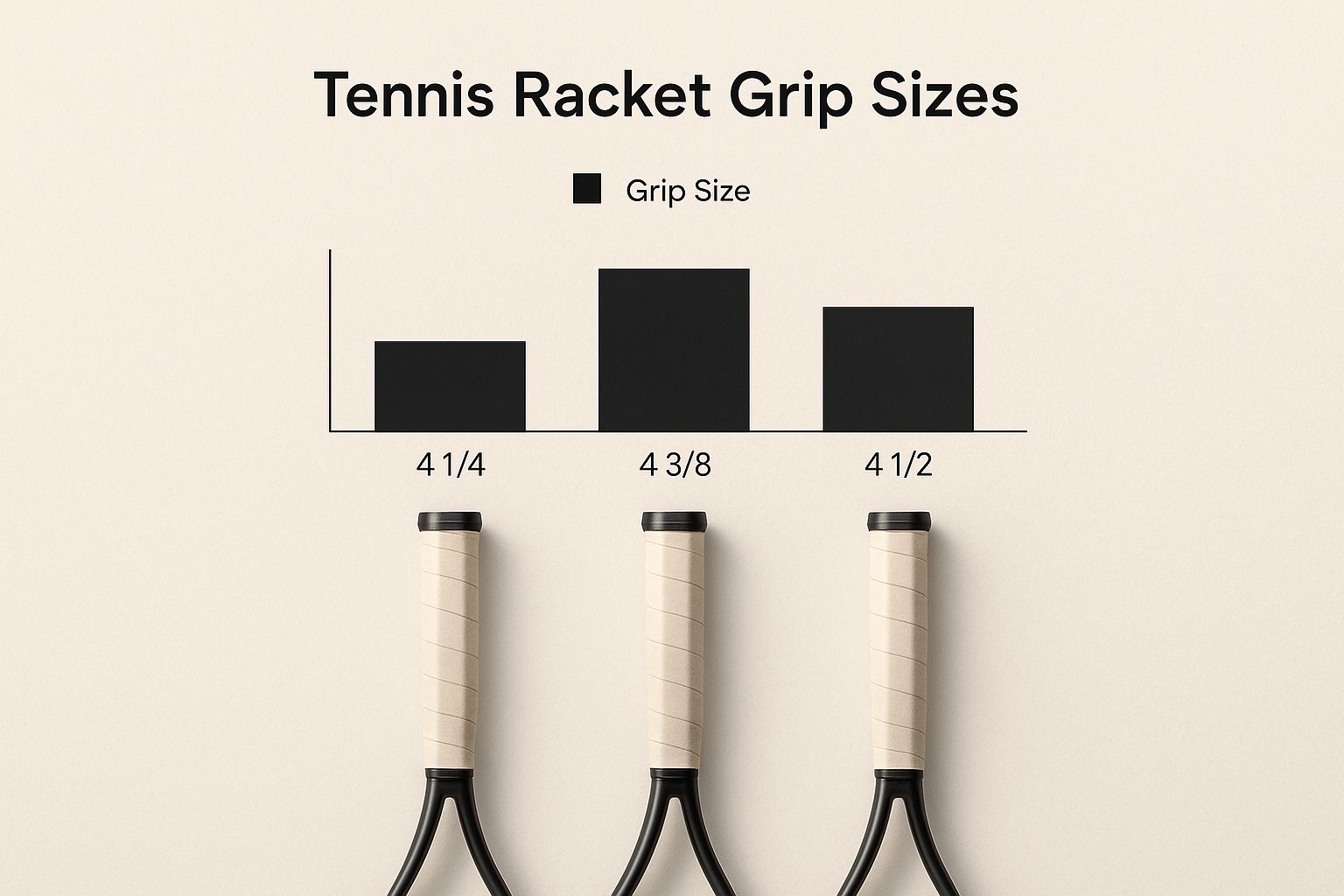
Stiffness and Beam Width
Finally, let's talk about the frame's stiffness and thickness. A racket's stiffness is measured with an RA rating. A high RA (70+) means the frame is very stiff. It won't bend much on impact, so it transfers more energy directly to the ball—hello, power!
A lower RA (below 65) means the frame is more flexible. It bends more upon contact, holding the ball on the strings a fraction of a second longer. This gives you more control, feel, and comfort.
The beam width—the thickness of the racket's frame—is directly linked to stiffness. As a rule of thumb, thicker beams are stiffer and more powerful, while thinner beams are more flexible and geared towards control. A player with a history of tennis elbow, for instance, would be wise to choose a more flexible, thinner-beamed racket to help absorb shock, even if it means giving up some "free" power. It’s all a compromise.
To make it easier, here’s a quick breakdown of how these specs influence performance.
Racket Specification Impact on Performance
This table shows how different racket specs tend to affect your game, helping you find the right balance of power, control, and comfort.
| Specification | Effect on Power | Effect on Control | Recommended For |
|---|---|---|---|
| Large Head Size (>105") | High | Low | Beginners needing forgiveness |
| Small Head Size (<97") | Low | High | Advanced players needing precision |
| Heavy Weight (>310g) | High (Stability) | High (Stability) | Advanced players who generate their own swing speed |
| Light Weight (<285g) | Medium (if Head-Heavy) | Low | Beginners/Intermediates needing manoeuvrability |
| Head-Heavy Balance | High | Low | Baseline players needing more momentum |
| Head-Light Balance | Low | High | All-court/Net players needing quick reactions |
| Stiff Frame (High RA) | High | Low | Players wanting free power and a crisp feel |
| Flexible Frame (Low RA) | Low | High | Players wanting more feel, comfort, and control |
Ultimately, there’s no single "best" setup. It’s about finding the right combination of specifications that complements your unique strengths and supports the areas you're working on.
Matching Your Racket to Your Playing Style
A tennis racket should be an extension of your body and your on-court philosophy. It's a piece of kit that needs to work with your natural tendencies, not against them. Choosing the right frame means aligning its characteristics with your game, which is the secret to amplifying your strengths and gaining a real competitive edge. For a deeper look into the technical side of things, Mantis has a fantastic guide on understanding tennis racket specifications that’s well worth a read.
This isn't about finding a racket that forces you to change how you play; it’s about finding one that feels like it was made just for you.
For the Solid Baseliner
If your game plan revolves around consistency, wearing opponents down from the back of the court, then you're a baseliner. You win points through relentless rallying, solid groundstrokes, and forcing errors. Your racket needs to be a dependable ally in this war of attrition.
A baseliner’s best friend is a frame that offers a great mix of power and stability. Look for rackets with a slightly larger head size, somewhere in the 98-102 sq. in. range, and a bit of heft (295-315g). This combination gives you a solid feel on contact, helping you absorb and redirect pace, while also providing enough pop to hit deep, penetrating shots.
An even or slightly head-light balance will keep the racket manoeuvrable enough for long rallies without tiring you out.
For the Aggressive All-Courter
The all-courter is the jack-of-all-trades. You’re just as happy trading blows from the baseline as you are moving forward to finish points at the net. Your game is all about variety and keeping your opponent guessing.
To support this versatile style, you need a racket that can do a little bit of everything well.
- Head Size: Go for something between 98-100 sq. in. This gives you a nice blend of control for your volleys and a generous enough sweet spot for your groundstrokes.
- Weight: A moderate weight (300-320g) provides enough mass for powerful shots but isn't too cumbersome for quick reactions at the net.
- Balance: A head-light balance is key here. It’s what gives you the racket head speed for big serves and the quick handling needed for crisp volleys.
This player thrives with a racket that feels like an extension of their arm—one that performs reliably from every part of the court.
For the Serve-and-Volley Specialist
While it's a rarer sight these days, the serve-and-volleyer is a formidable opponent who applies constant pressure. If you hunt for every opportunity to close the net and end points quickly, this is your style. Your game demands precision, feel, and lightning-fast reflexes.
A serve-and-volleyer’s racket has to be exceptionally manoeuvrable and offer a superb connection to the ball. We’d suggest looking for a lighter frame (290-310g) with a distinctly head-light balance, which allows for rapid adjustments and quick hands at the net.
Feel is everything. A more flexible frame with a thinner beam will give you the feedback needed for those delicate touch volleys and drop shots. For this style, control is far more important than raw power.
The right racket instils confidence. When you trust your equipment, you're free to play instinctively, whether that means ripping a forehand down the line or feathering a drop volley for a winner. Finding that perfect match is a game-changer.
For the Modern Spin Player and Counter-Puncher
The modern game is often dominated by heavy topspin and aggressive counter-punching. Players with this style use wicked spin to create high-bouncing shots that push opponents back, opening up the court for angles and winners.
If you build your game around spin, the string pattern is a critical spec to get right.
- Open String Pattern (e.g., 16x19): This is the go-to for most modern players. The wider gaps between strings allow them to move more freely and really "bite" into the ball, generating massive topspin. This "trampoline effect" also adds a bit more power and depth to your shots.
- Dense String Pattern (e.g., 18x20): This pattern gives you more control and is usually favoured by players who hit flatter and value precision above all. You get a more connected feel to the stringbed, but you'll have to generate more of your own spin.
For a spin-heavy game, you’ll want to pair an open string pattern with a racket that has a moderate weight and a fast, aerodynamic frame. This lets you whip the racket head through the hitting zone, which is the real engine behind those high-revving shots you see on tour today.
Why Your Strings and Grip Are Just as Important as the Frame
The frame gets all the glory, but a tennis racket is a system. The strings and grip are your direct connection to the ball, and customising them is what turns a good racket into a great one. Think of it this way: the frame is the chassis, but the strings are the engine and the grip is the steering wheel. For a complete picture, our guide on how to choose a tennis racket is a great place to start.
Here at Mantis, we know that a setup tailored perfectly to your game gives you the confidence to go for every shot. This is where you fine-tune the racket’s power, control, and comfort to match exactly what you need on court.
Decoding the World of Tennis Strings
Strings are what dictate how the ball reacts when it leaves your racket. They influence everything from pace and spin to feel and arm comfort. There are three main families, each with a distinct personality.
- Polyester (Poly): The go-to choice for most intermediate and advanced players. Poly strings are firm, durable, and offer phenomenal spin potential. They give players with fast swings the freedom to hit out without worrying about the ball flying long.
- Multifilament: Made from thousands of tiny fibres woven together, these strings are engineered to feel like natural gut. They provide excellent comfort and power, making them a fantastic option for players with sensitive arms or those who want a bit more pop.
- Natural Gut: The gold standard for feel and playability. Nothing matches natural gut’s combination of power, comfort, and tension stability. It's the most expensive option for a reason—its performance is simply second to none.
Many players now opt for a hybrid setup, which means using two different types of string in the same racket. A common combination is pairing a control-oriented polyester with a softer multifilament or natural gut. This approach lets you blend the best of both worlds, like getting the control of poly with the comfort of a softer string.
The Critical Role of String Tension
String tension, measured in pounds (lbs) or kilograms (kg), is simply how tightly the strings are pulled within the frame. This one number has a massive impact on your racket's performance.
It's a common myth that higher tension gives you more power. In reality, the opposite is true. Lower tension creates a deeper pocketing effect, launching the ball with more speed and offering a more forgiving sweet spot.
Here’s an easy way to think about it:
- Lower Tension (e.g., 45-50 lbs): This gives you more power, better comfort, and a plusher feel. It’s ideal if you’re looking for more depth on your shots or need to protect your arm from harsh vibrations.
- Higher Tension (e.g., 55-60 lbs): This delivers more control and a crisp, precise response. The stringbed feels firmer, which is perfect for advanced players who generate their own pace and prioritise shot placement.
Mastering Your Grip for Control and Comfort
Your entire connection to the racket starts and ends with the grip. Using the wrong grip size isn't just uncomfortable; it can lead to injuries like tennis elbow because it forces you to squeeze the handle too hard.
Finding your size is simple. Hold the racket with a forehand grip. You should be able to slide the index finger of your other hand snugly into the gap between your palm and your ring finger.
Players also customise their grip feel with two different layers:
- Replacement Grips: This is the base grip that’s installed on the racket’s handle from the factory.
- Overgrips: These are much thinner grips that you wrap over the replacement grip. They add tackiness, absorb sweat, and can slightly build up the handle size. Most competitive players change their overgrip often to keep that fresh, consistent feel.
The passion players have for getting their setup just right is reflected in the market. The global tennis racket market was valued at $616.72 million USD in 2024, with Europe’s market share sitting at 26.86%. The UK’s slice of that pie represents a significant $19 million USD. This growth shows just how much players are willing to invest in finding their perfect gear.
How to Demo and Make Your Final Decision
Theory and specs are a great starting point, but let's be honest: on-court feel is everything. After all that research, you’ve probably got a shortlist of a few promising frames. Now for the most important part of buying a new tennis racket—the demo. For a full rundown of the journey, our main guide on how to choose a tennis racket is a brilliant resource.
Here at Mantis, we can’t stress this enough. Every player, no matter their level, should playtest a racket before committing. It's the only real way to know if your investment is the right one. This is the final, crucial step that bridges the gap between the numbers on paper and how a racket actually performs in your hand.
A racket that looks perfect in theory might feel completely wrong, while one you almost overlooked could be the one. The demo is where your research gets validated.
Selecting Your Demo Rackets
Right, let’s get focused. Based on your research, pick out two or three different frames to test. It’s tempting to try five or six, but trust us, that usually leads to confusion, not clarity.
A smart approach is to choose frames with slight, meaningful variations. For example, you could try:
- Your number one choice based on the specs.
- A similar racket from another brand, or one with a slightly different weight or balance.
- A "wild card" that just intrigues you—maybe it has a different head size or string pattern.
This gives you a solid baseline for comparison but still leaves a little room for a pleasant surprise.
Conducting an Effective Playtest
When you take your demo rackets to the court, go in with a plan. Just tapping a few balls back and forth won’t cut it. You need to put each frame through its paces properly to understand its true character.
We recommend spending at least an hour with each racket, hitting every shot you’d use in a match. This gives the racket a proper chance to show you what it's made of.
Pay close attention to how the racket performs, but also how it makes you feel. The best racket is the one that gives you the confidence to go for your shots under pressure. It should feel like a natural extension of your arm.
To get the full picture, make sure you cover the essentials:
- Groundstrokes: Hit plenty of forehands and backhands. Notice the depth and spin you're getting. How does it feel when you’re defending versus when you’re attacking the ball?
- Serves: Go through your service motion for both first and second serves. Does the racket give you easy power, or does it deliver the control you need to place that crucial second serve?
- Volleys: Get up to the net. Test out crisp, punchy volleys as well as softer touch shots. Check for manoeuvrability and how stable the frame feels against a heavy-hitter.
- Specialty Shots: Don't forget the other shots that win matches—lobs, overheads, and slices. A racket might feel amazing from the baseline but awkward on other important shots.
What to Look For Beyond Power and Control
While power and control are the big two, other factors are just as vital for long-term satisfaction. The most important of these is comfort.
After an hour of hitting, how does your arm feel? Take note of any harshness or weird vibrations, especially on shots you hit off-centre. A racket that feels even slightly uncomfortable during a demo will only cause more problems down the line.
This focus on the player experience is driving a healthy market. In Europe, the tennis racket industry is set to be worth $143.56 million USD in 2025 and is projected to climb to $196.13 million USD by 2033. The UK, with its army of passionate players, makes up a significant 13.32% of that, a market of around $19.1 million USD. This growth shows that players are becoming more knowledgeable and are prepared to invest in finding the perfect gear. You can find more on these trends in this comprehensive report on the tennis rackets market.
To keep your thoughts organised, take notes right after each session. A simple table works wonders.
| Racket Model | Forehand | Backhand | Serve | Volley | Comfort | Overall Feel |
|---|---|---|---|---|---|---|
| Demo 1 | ||||||
| Demo 2 | ||||||
| Demo 3 |
This simple trick stops the details from blurring together. In the end, the choice comes down to which racket ticks the most boxes and, crucially, just feels right. Trust your gut—the best frame is the one you can’t wait to get back on court with.
Common Questions When Buying a Tennis Racket
Choosing a racket can bring up a lot of last-minute questions, even after you’ve done your research. To help you feel completely confident in your decision, we at Mantis have put together some answers to the most common queries we get from players. If you feel like you need a refresher on the basics first, our complete guide on how to choose a tennis racket is a great place to start.
Making an informed choice is the best way to ensure you end up with a frame that truly complements your game.
How Often Should I Replace My Racket?
This is a question we hear all the time, and the honest answer is: it really depends on how often and how seriously you play. Think of a racket frame like a high-performance car – it has a lifespan where it performs at its absolute best.
For serious club or tournament players who are on court several times a week, the racket's materials will gradually soften and lose their responsiveness. We recommend these players think about getting a new frame every 1-2 years to maintain peak performance.
If you’re a casual player who hits a few times a month, the frame itself can last for many years without a noticeable drop in performance. The strings, however, are a different story. To keep the racket feeling playable, even a casual player should restring at least once a year—or follow the old rule of thumb: restring as many times per year as you play per week.
What's the Biggest Mistake Beginners Make?
Without a doubt, the most common pitfall for newcomers is buying a racket that’s far too heavy and advanced for them. This usually happens when they see a pro using a specific model and assume it’s the key to success.
The reality is that pro-level rackets are designed for athletes who have spent years perfecting their technique and can generate their own power. A beginner using one will struggle, likely develop bad habits, and could even risk injury.
For someone just starting out, a completely different set of features will make the learning process much more enjoyable and effective. Beginners thrive with:
- A lighter racket for an easier, more natural swing.
- A larger head size to provide a bigger sweet spot and more forgiveness on off-centre shots.
- A head-heavy balance which helps generate easy power while your technique develops.
Starting with a user-friendly racket helps build a solid foundation and keeps the game fun.
Does the String Pattern Really Make a Difference?
Yes, absolutely. The string pattern—the number of main (vertical) and cross (horizontal) strings—has a massive impact on how the racket feels and performs. It’s all about the trade-off between spin and control.
An open string pattern, like a 16x19, has wider spacing between the strings. This allows the strings to snap back into place more forcefully on impact, literally "biting" into the ball to generate significantly more topspin. It also produces a livelier, more powerful response, making it a popular choice for the modern, aggressive player.
On the other hand, a dense string pattern, such as 18x20, features tighter spacing. This creates a firmer, more controlled feel. It’s favoured by players who hit a flatter ball and prioritise precision over raw power and spin. You give up some of that "free" spin, but you gain a more direct, connected feel for pinpoint accuracy. Ultimately, the right choice comes down to your playing style and what you want from your racket.
At Mantis, we are dedicated to crafting high-performance tennis equipment with purpose. We focus on the details that matter—premium materials, precise weight distribution, and exceptional feel—to give you the tools you need to progress. Explore our collection of rackets, strings, and accessories at https://mantissport.com.
